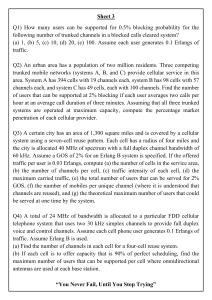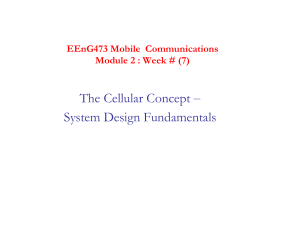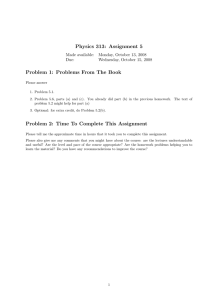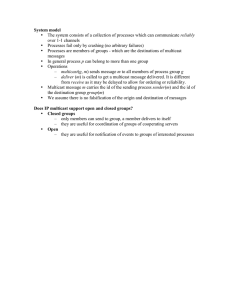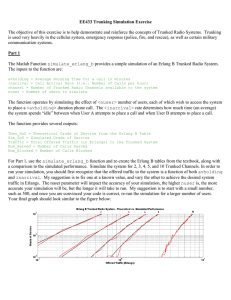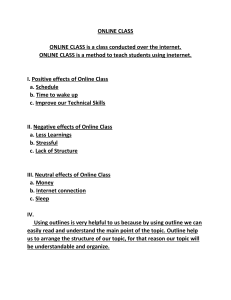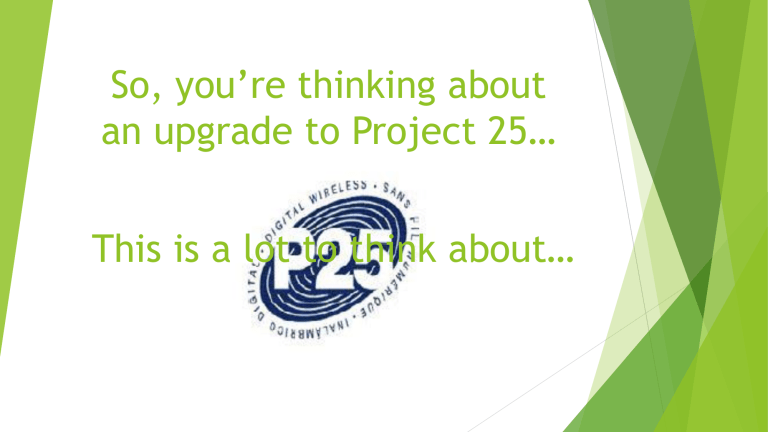
So, you’re thinking about an upgrade to Project 25… This is a lot to think about… Three Main Considerations: Internal Culture – the specific organizational and operational needs of the end-users and maintainers Procurement, Funding and Sustainment – through federal grant programs for acquisition of Project 25 systems and subscribers Technology – with it’s many variations that can be customized to the needs of the end-users and maintainers, and to the satisfaction of key stakeholders Internal Cultural Issues Your internal organizations and user’s groups have particular needs which must be addressed: How does the transition from analog to digital affect them? How do we organize your users’ groups to maximize efficiencies? How do we maintain or broker required ‘Interoperability’ with other agencies in adjacent cities/counties or States? How do we resolve the ‘understanding gap’? Internal Cultural Issues: The Solution Education and Training Fleet Mapping If you aren’t already ‘trunked’, this process can be daunting Coalition Building for Interoperability A must when introducing any new technology; and it’s a big part of our commitment to you We stand with all our customers Understanding It’s important that we understand your problems. It’s equally important that you understand our solutions! Procurement, Funding and Sustainment SAFECOM – administers the federal grant program to provide funding and sustainment money for Project 25 equipment Office of Emergency Communications – grant guidance for what can and can’t be bought w/SAFECOM funds FPIC – coordination and advisory body to address technical and wireless operational issues relative to interoperability Your own Program Management Office in charge of procurement – how that federal money is spent - can be of enormous value in organizing and measuring the efforts of vendors, consultants and your own stakeholders Technology Coverage – signal strength which fades with distance from a transmit site Network Architecture: Simulcast, Multicast or ‘Hybrid’ Trunked or Conventional Repeat Grade of Service – Erlang C Frequencies, Bandwidth and Standards Delivered Audio Quality and Bit Error Rate Coverage Modeled in software Overlaid in Google Earth Often a very good representation of actual system performance BUT IT’S ONLY A MODEL! Coverage A Note About Coverage: Prior slide was ‘talk out’ from a 100 watt repeater Most P25 systems will be ‘uplink limited’ – the ‘talk in’ footprint will be smaller Static Sensitivity vs. Faded Sensitivity Just because your portable’s static sensitivity measurement of 5% BER is better than the ‘green’ (-80 dBm) area, it’s not a guarantee that you’ll be able to affiliate with that station in a P25 system – faded sensitivity can be much worse! Simulcast, Multicast or ‘Hybrid’ Simulcast Multicast In a multi-site system, one channel at each of the sites transmits the same signal on the same frequency. In a multi-site system, one channel at each of the sites transmits the same signal on a different frequency. Frequency efficient Frequency consuming Requires identical number of repeaters at each site Allows for a different number of repeaters at each site Requires ‘voting’ technology Trunked multicast does not require ‘voting’ (i.e. different channels – no overlap of same signal) Simulcast, Multicast or ‘Hybrid’ For most Public Safety applications, Simulcast is the preferred architecture Pro: ease of use and more spectrally efficient Con: higher initial cost and total cost of ownership Multicast applications can be cost-effective in low-density areas Hybridized systems can be designed to include elements of both Trunked or Conventional Repeat Choice here should be based on the number of users of the system, against the number of available channels Project 25 systems can be configured either way Properly configured, a P25 conventional system can offer many of the same managed services as a trunked version; at significant savings to the buyer “Trunking is a way for a large number of users to share a small number of channels” Trunked or Conventional Repeat Single-site trunked system Single-site conventional repeater system Trunked vs. Conventional P25 Trunked Conventional More complex and less available Less complex, always available Greater initial expense and total cost of ownership Less expensive and more easily maintained Added growth depends on the acquisition of more channels or migration to Project 25/Phase 2 Can later be upgraded to trunking Grade of Service (trunked systems) For most Public Safety applications, a 5% G.O.S. is acceptable. 5% G.O.S. means the user will experience a busy signal when he keys his/her radio, 5% of the time. 95% of the time, that same user will obtain a channel grant/talk permit tone and can begin speaking to the talk-group. At this G.O.S. a 5-channel system can sustain between 50-70 users per channel, depending on ‘hold time’ In P25 systems, one channel at each trunked site is a dedicated ‘control channel’ that receives and sends channel requests and assignments Too many talk groups programmed into the system tend to erode this service and make it less available to all users! Grade of Service (trunked systems) Frequencies, Bandwidth and Standards Project 25 Phase 1 operates on 12.5 kHz channels 800 MHz channels were planned this way from the beginning VHF High Band and UHF channels have since been similarly ‘narrow-banded’ In 2014, the FCC issued a report and order eliminating the mandate for all 700 MHz radios to operate Project 25/Phase 2 (6.25 kHz/talk path) by December 31, 2016. 700 MHz – except for those portions of the band designated for broadband – can now be developed; but must operate on the Phase 1 standard. This creates a migration path for those public safety licensees with UHF T-Band channels, who must vacate the band by 2021 Frequencies, Bandwidth and Standards The Project 25 Suite of Standards is still evolving The Common Air Interface Standard (1993) which includes: The method of trunking (a ‘slotted aloha’ technique) Narrow-banding from the original 25 kHz channel plan to 12.5 kHz The current vocoder (voice encoder) – IMBE (Improved Multi-Band Excitation) Phase 2 systems will use the AMBE (Advanced Multi-Band Excitation) vocoder The Inter-RF Sub-System Interface Allows different manufacturer’s systems to be directly interconnected at the controller level The Console Sub-System Interface Allows dispatch consoles from different manufacturer’s to be connected to the core/controller of other manufacturer’s systems Frequencies, Bandwidth and Standards Standards are established and reviewed by the TIA’s TR-8 Subcommittee several times/year. Delivered Audio Quality (DAQ) Mean opinion scores from tests have created the following descriptors of speech recognition: DAQ Description 1 Unusable. Speech present but not understandable. 2 Speech understandable with considerable effort. Requires frequent repetition due to noise or distortion. 3 Speech understandable with slight effort. Requires occasional repetition due to noise or distortion. 3.4 4 4.5 5 Speech understandable without repetition. Some noise or distortion present. Speech easily understandable. Little noise or distortion. Speed easily understandable. Rare noise or distortion. Perfect. No distortion or noise discernible. Bit Error Rate A Bit Error Rate (BER) of 5% equates to a received signal strength roughly equal to the same signal strength one would see for 12 dB SINAD A BER of between 2 – 2.5 % is what’s been shown to produce a DAQ of 3.4 (speech understandable without repetition) Depends on the results of Mean Opinion Scores For this reason, Project 25 voice quality is perceived to be a significant drawback for some users. Pros and Cons of Project 25 Pros Proven in Public Safety use for over 15 years Scalable to suit the size of your agency Interoperability with other vendors assured through the CAP (Compliance Assessment Program) Multiple vendors from which to choose Backward compatible and ‘future proof’ Cons Voice Quality a concern for some Low immunity to interference and multipath effects compared to analog systems Data transmission limit of 9.6 kbps Sharp drop off in voice quality under low signal conditions make P25 inappropriate for ‘Fireground’ Latency No support for paging Questions?
